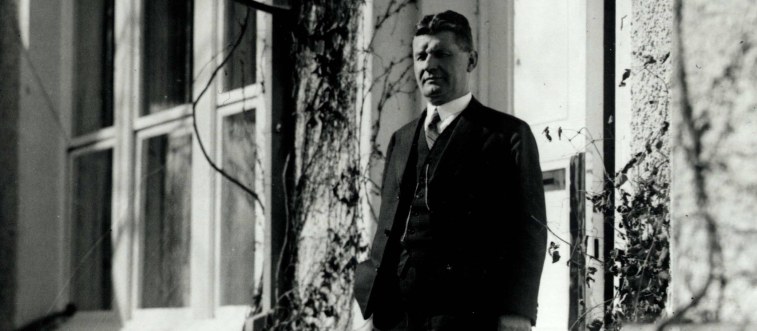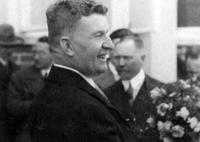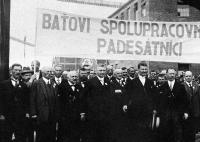
Bata's Zlin
The Baťa brothers established the shoemaking company on 21 September 1894. It developed favourably, and development of the whole town began to accelerate. The old town of artisans and tradesmen became an important industrial centre. Soon, the new shoemaking company managed by Tomáš Baťa (1876–1932) built modern factory buildings (1900, 1906). The number of workers increased and the good name of Baťa shoes spread. Baťa's example was followed by other entrepreneurs, and another five shoemaking factories were established in Zlín between 1899 and 1910. Around 1910, Zlín reached the position of an important shoemaking industry centre. Mayor F. Štěpánek played a major role in the modernization of the town and in enlivening public life.
 During World War I, the Zlín factories supplied millions of pairs of shoes to the Austro-Hungarian army, and production kept rising. In 1918, Baťa's factory employed 4,000 people. The post-war crisis strangled development and the smaller factories in Zlín closed. Baťa's company survived but had to reduce production. The social democrats and later the communists (1919–1923) took power in Zlín Town Hall.
During World War I, the Zlín factories supplied millions of pairs of shoes to the Austro-Hungarian army, and production kept rising. In 1918, Baťa's factory employed 4,000 people. The post-war crisis strangled development and the smaller factories in Zlín closed. Baťa's company survived but had to reduce production. The social democrats and later the communists (1919–1923) took power in Zlín Town Hall.
Baťa survived the crisis by a bold decision: in September 1922, he reduced the price of his shoes by half. He immediately won thousands of customers with his cheap products; Baťa conquered the market and became the Czechoslovak king of shoes. His Zlín company launched unprecedented development. Between 1923 and 1938, a large factory compound with dozens of modern buildings grew in the town's suburb. The company, equipped with the latest machinery, hired thousands of new employees, and the company supplied millions of pairs of shoes. Besides, it also produced machines, rubber, chemical and textile products, etc. A chain of Baťa shoe shops grew in Czechoslovakia and many European countries.
Zlín also changed alongside the company's expansion, especially when Tomáš Baťa became the mayor in 1923. The company built department stores, a hotel, a cinema, a large hospital, schools, scientific buildings, film studios and thousands of cheap flats. The population started to grow: 4,678 in 1921, 21,582 in 1930 and 37,342 in 1937. The feverish building activity shaped Zlín into an ultramodern industrial town. However, the building was not unrestrained and followed modern urban concepts. The works of significant architects (J. Kotěra, F. L. Gahura, V. Karfík, M. Lorenc) gave Zlín the unique European character of a Functionalist town, which attracted the attention of the famous architect Le Corbusier.
 After the death of Tomáš Baťa in 1932, company management was assumed by his colleagues D. Čipera, H. Vavrečka and J. Hlavnička; Jan Antonín Baťa became the company director. Affiliated companies were established all over Czechoslovakia together with new factories, business companies and shoe shops throughout Europe, Asia, Africa and America. Thus, many "little Zlíns" can still be found all over the world. In 1938, Baťa's companies employed 65,064 people - 41,814 in Czechoslovakia and 23,250 abroad. Zlín was the seat of Baťa's global shoe company, a town that gathered business and manufacturing contacts from almost the entire world.
After the death of Tomáš Baťa in 1932, company management was assumed by his colleagues D. Čipera, H. Vavrečka and J. Hlavnička; Jan Antonín Baťa became the company director. Affiliated companies were established all over Czechoslovakia together with new factories, business companies and shoe shops throughout Europe, Asia, Africa and America. Thus, many "little Zlíns" can still be found all over the world. In 1938, Baťa's companies employed 65,064 people - 41,814 in Czechoslovakia and 23,250 abroad. Zlín was the seat of Baťa's global shoe company, a town that gathered business and manufacturing contacts from almost the entire world.
However, the catastrophic consequences of the Munich Agreement, German occupation and World War II stopped the advance of Baťa's plants and Zlín itself. German occupation subjected the plants to the war regime, while American bombardment destroyed a large portion of Zlín factories in 1944. The wartime hardship ended with the liberation of the town by the Soviet and Rumanian armies on 2 May 1945.
-----
The texts were taken from the brochure Zlín - A Town in Gardens, written by L. Horňáková, P. Novák and Z. Pokluda and published by the Town of Zlín in 2005.